Кириллица сербская: Сербский кириллица — frwiki.wiki
Содержание
Сербский кириллица — frwiki.wiki
Современная сербская кириллица (Azbuka) имеет 30 буквы кириллицы, и каждый из них соответствует звуку.
Алфавит был создан Вуком Стефановичем Караджичем в 1818 году и стал официальным письмом Сербии в 1868 году . Вук Стефанович Караджич создал его из русского алфавита, который в то время также использовался в Сербии. Сербская кириллица вместе с работами Крсте Мисиркова и Венко Марковского послужила основой для македонской кириллицы.
Он удалил некоторые буквы, такие как: і, ю, й, ъ, ь, щ, я и другие, и добавил шесть новых букв ћ, ђ, љ, њ, ј и џ. Ћ был взят из старой глаголицы из метода, с православным монахом (сам из славянского происхождения), который пришел к евангелизации славян Юга и Запад в 894 ; ђ был создан Лукианом Мушицким из ћ, љ и њ — лигатуры л + ь и н + ь; ј происходит от латинского алфавита, а џ происходит от старого румынского кириллического алфавита.
Резюме
- 1 сербский кириллица и латинский алфавит
- 2 Таблица двух сербских алфавитов
- 3 Примечания и ссылки
- 4 См.
 Также
Также- 4.1 Связанные статьи
- 4.2 Внешние ссылки
Сербский кириллица и латинский алфавит
В Сербии сербский пишется двумя алфавитами : кириллицей и сербской латиницей . Кириллица используется ведущими газетами, такими как « Политика» ( Le Monde serbe). Газеты с латинским алфавитом более универсальные, менее «элитарные» и более «популярные», такие как Blic, или «оппозиционные» или «прогрессивные» газеты, такие как Danas .
Два алфавита почти взаимно однозначны, то есть переход от одного к другому следует механическим правилам без потерь; однако несколько слов являются исключением, например, injekcija / инјекција (инъекция), где буквы -nj- отвечают -н-, а не њ.
Администрация Сербии отдает предпочтение кириллице ( правительство Сербии ), но также использует латинский алфавит (см. Посольство Сербии во Франции ). Вот почему всем сербам важно знать два алфавита. При обучении письму и чтению все дети изучают оба алфавита.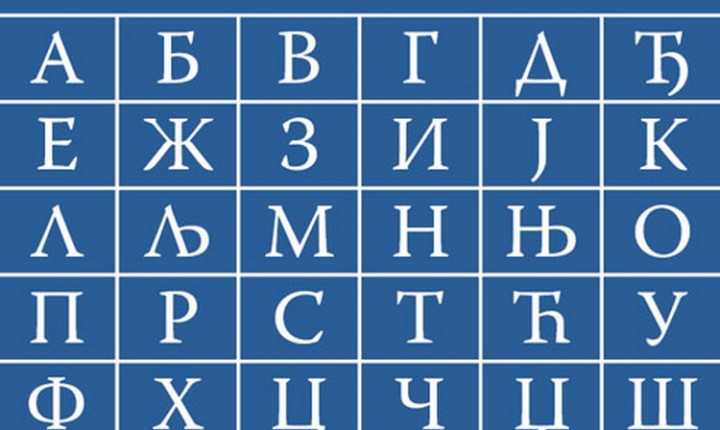
Таблица двух сербских алфавитов
Таблица двух сербского, латинского и кириллического алфавита в ( 1818 г. ).
| Кириллица | латинский | API |
|---|---|---|
| А а | В | /в/ |
| Б б | B | / b / |
| В в | V | / v / |
| Г г | грамм | / грамм / |
| Д д | D | / d / |
| Ђ ђ | Ð | / d͡ʑ / |
| Е е | E | / ɛ / |
| Ж ж | Ž | / ʒ / |
| З з | Z | / z / |
| И и | я | / я / |
| Ј ј | J | / d / |
| К к | K | / k / |
| Л л | L | / л / |
| Љ љ | Lj | / ʎ / |
| М м | M | / м / |
| Н н | НЕТ | /нет/ |
| Њ њ | Nj | / ɲ / |
| О о | О | / ɔ / |
| П п | п | / п / |
| Р р | р | / р / |
| С с | S | / с / |
| Т т | Т | / т / |
| Ћ ћ | ПРОТИВ | / t͡ɕ / |
| У у | U | / u / |
| Ф ф | F | / f / |
| Х х | ЧАС | / x / или / h / |
| Ц ц | ПРОТИВ | / ʦ / |
| Ч ч | ПРОТИВ | / t͡ʃ / |
| Џ џ | Dž | / d͡ʒ / |
| Ш ш | Š | / ʃ / |
Примечания и ссылки
Смотрите также
Статьи по Теме
- сербский
- Сербский латинский алфавит
- Кирилл и Метод
- Гадж алфавит
- Глаголица
- Православная Церковь
Внешние ссылки
- История происхождения кириллицы
<img src=»//fr.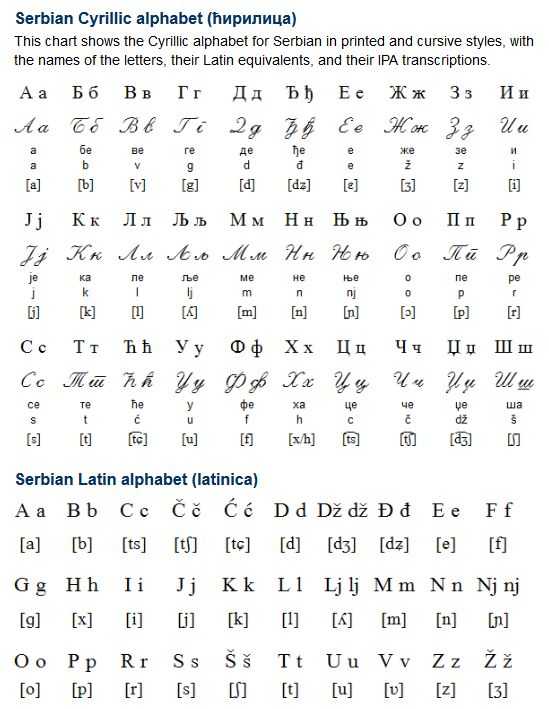 wikipedia.org/wiki/Special:CentralAutoLogin/start?type=1×1″ alt=»» title=»»>
wikipedia.org/wiki/Special:CentralAutoLogin/start?type=1×1″ alt=»» title=»»>
Serbian Cyrillic alphabet — Wikipedia
«Serbian alphabet» redirects here. For the Serbian Latin alphabet, see Gaj’s Latin alphabet.
This article contains special characters. Without proper rendering support, you may see question marks, boxes, or other symbols.
The Serbian Cyrillic alphabet (Serbian: Српска ћирилица / Srpska ćirilica, pronounced [sr̩̂pskaː tɕirǐlitsa]) is a variation of the Cyrillic script used to write the Serbian language, updated in 1818 by Serbian linguist Vuk Karadžić. It is one of the two alphabets used to write standard modern Serbian, the other being Gaj’s Latin alphabet.
Karadžić based his alphabet on the previous Slavonic-Serbian script, following the principle of «write as you speak and read as it is written», removing obsolete letters and letters representing iotified vowels, introducing ⟨J⟩ from the Latin alphabet instead, and adding several consonant letters for sounds specific to Serbian phonology. During the same period, linguists led by Ljudevit Gaj adapted the Latin alphabet, in use in western South Slavic areas, using the same principles. As a result of this joint effort, Serbian Cyrillic and Gaj’s Latin alphabets for Serbian-Croatian have a complete one-to-one congruence, with the Latin digraphs Lj, Nj, and Dž counting as single letters.
During the same period, linguists led by Ljudevit Gaj adapted the Latin alphabet, in use in western South Slavic areas, using the same principles. As a result of this joint effort, Serbian Cyrillic and Gaj’s Latin alphabets for Serbian-Croatian have a complete one-to-one congruence, with the Latin digraphs Lj, Nj, and Dž counting as single letters.
Karadžić’s Cyrillic alphabet was officially adopted in Serbia in 1868, and was in exclusive use in the country up to the interwar period. Both alphabets were official in the Kingdom of Yugoslavia and later in the Socialist Federal Republic of Yugoslavia. Due to the shared cultural area, Gaj’s Latin alphabet saw a gradual adoption in Serbia since, and both scripts are used to write modern standard Serbian. In Serbia, Cyrillic is seen as being more traditional, and has the official status (designated in the constitution as the «official script», compared to Latin’s status of «script in official use» designated by a lower-level act, for national minorities).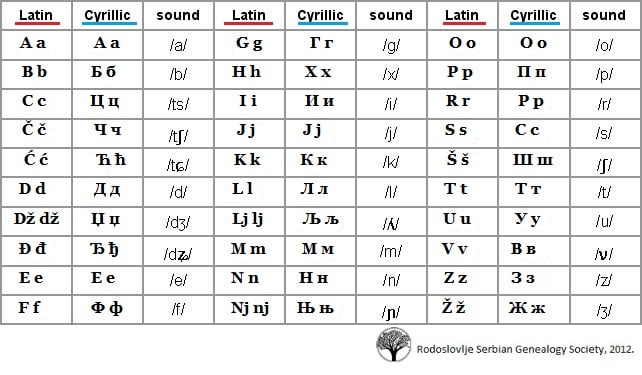 It is also an official script in Bosnia and Herzegovina and Montenegro, along with Gaj’s Latin.
It is also an official script in Bosnia and Herzegovina and Montenegro, along with Gaj’s Latin.
Contents
- 1 Official use
- 2 Modern alphabet
- 3 Early history
- 3.1 Early Cyrillic
- 3.2 Medieval Serbian Cyrillic
- 4 Karadžić’s reform
- 5 Modern history
- 5.1 Austria-Hungary
- 5.2 World War II
- 5.3 Yugoslavia
- 5.4 Contemporary period
- 6 Special letters
- 7 Differences from other Cyrillic alphabets
- 8 Keyboard layout
- 9 See also
- 10 References
- 10.1 Citations
- 10.2 Sources
- 11 External links
Official use[edit]
Serbian Cyrillic is in official use in Serbia, Montenegro and Bosnia and Herzegovina.[2] Although Bosnia «officially accept[s] both alphabets»,[2] the Latin script is almost always used in the Federation of Bosnia and Herzegovina,[2] whereas Cyrillic is in everyday use in Republika Srpska.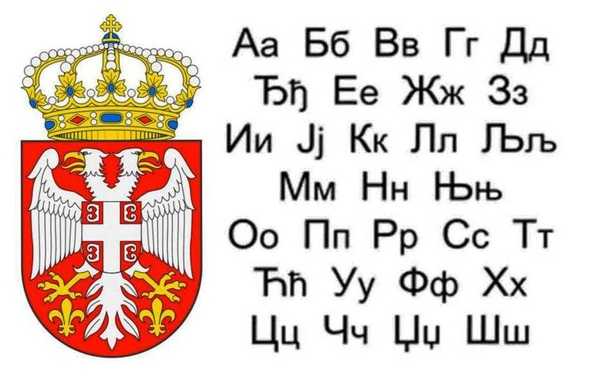 [2][3] The Serbian language in Croatia is officially recognized as a minority language; however, the use of Cyrillic in bilingual signs has sparked protests and vandalism.
[2][3] The Serbian language in Croatia is officially recognized as a minority language; however, the use of Cyrillic in bilingual signs has sparked protests and vandalism.
Serbian Cyrillic is an important symbol of Serbian identity.[4] In Serbia, official documents are printed in Cyrillic only[5] even though, according to a 2014 survey, 47% of the Serbian population write in the Latin alphabet whereas 36% write in Cyrillic.[6]
Modern alphabet[edit]
Example of typical cursive modern Serbian Cyrillic alphabet
Capital letters of the Serbian Cyrillic alphabet
The following table provides the upper and lower case forms of the Serbian Cyrillic alphabet, along with the equivalent forms in the Serbian Latin alphabet and the International Phonetic Alphabet (IPA) value for each letter. The letters do not have names, and consonants are normally pronounced as such when spelling is necessary (or followed by a short schwa, e. g. /fə/).:
g. /fə/).:
|
|
Summary tables
| A | a | B | b | C | c | Č | č | Ć | ć | D | d | Dž | dž | Đ | đ | E | e | F | f | G | g | H | h | I | i | J | j | K | k |
| А | а | Б | б | Ц | ц | Ч | ч | Ћ | ћ | Д | д | Џ | џ | Ђ | ђ | Е | е | Ф | ф | Г | г | Х | х | И | и | Ј | ј | К | к |
| L | l | Lj | lj | M | m | N | n | Nj | nj | O | o | P | p | R | r | S | s | Š | š | T | t | U | u | V | v | Z | z | Ž | ž |
| Л | л | Љ | љ | М | м | Н | н | Њ | њ | О | о | П | п | Р | р | С | с | Ш | ш | Т | т | У | у | В | в | З | з | Ж | ж |
| А | а | Б | б | В | в | Г | г | Д | д | Ђ | ђ | Е | е | Ж | ж | З | з | И | и | Ј | ј | К | к | Л | л | Љ | љ | М | м |
| A | a | B | b | V | v | G | g | D | d | Đ | đ | E | e | Ž | ž | Z | z | I | i | J | j | K | k | L | l | Lj | lj | M | m |
| Н | н | Њ | њ | О | о | П | п | Р | р | С | с | Т | т | Ћ | ћ | У | у | Ф | ф | Х | х | Ц | ц | Ч | ч | Џ | џ | Ш | ш |
| N | n | Nj | nj | O | o | P | p | R | r | S | s | T | t | Ć | ć | U | u | F | f | H | h | C | c | Č | č | Dž | dž | Š | š |
Early history[edit]
See also: History of Serbia
Serbian Cyrillic, from Comparative orthography of European languages. Source: Vuk Stefanović Karadžić «Srpske narodne pjesme» (Serbian folk poems), Vienna, 1841
Source: Vuk Stefanović Karadžić «Srpske narodne pjesme» (Serbian folk poems), Vienna, 1841
Early Cyrillic[edit]
Main article: Early Cyrillic
According to tradition, Glagolitic was invented by the Byzantine Christian missionaries and brothers Saints Cyril and Methodius in the 860s, amid the Christianization of the Slavs. Glagolitic alphabet appears to be older, predating the introduction of Christianity, only formalized by Cyril and expanded to cover non-Greek sounds. The Glagolitic alphabet was gradually superseded in later centuries by the Cyrillic script, developed around by Cyril’s disciples, perhaps at the Preslav Literary School at the end of the 9th century.[7]
The earliest form of Cyrillic was the ustav, based on Greek uncial script, augmented by ligatures and letters from the Glagolitic alphabet for consonants not found in Greek. There was no distinction between capital and lowercase letters. The standard language was based on the Slavic dialect of Thessaloniki. [7]
[7]
Medieval Serbian Cyrillic[edit]
See also: Serbian manuscripts and Srbulja
Part of the Serbian literary heritage of the Middle Ages are works such as Miroslav Gospel, Vukan Gospels, St. Sava’s Nomocanon, Dušan’s Code, Munich Serbian Psalter, and others. The first printed book in Serbian was the Cetinje Octoechos (1494).
Karadžić’s reform[edit]
Vuk Karadžić.
Vuk Stefanović Karadžić fled Serbia during the Serbian Revolution in 1813, to Vienna. There he met Jernej Kopitar, a linguist with interest in slavistics. Kopitar and Sava Mrkalj helped Vuk to reform Serbian and its orthography. He finalized the alphabet in 1818 with the Serbian Dictionary.
Karadžić reformed standard Serbian and standardised the Serbian Cyrillic alphabet by following strict phonemic principles on the Johann Christoph Adelung’ model and Jan Hus’ Czech alphabet. Karadžić’s reforms of standard Serbian modernised it and distanced it from Serbian and Russian Church Slavonic, instead bringing it closer to common folk speech, specifically, to the dialect of Eastern Herzegovina which he spoke. Karadžić was, together with Đuro Daničić, the main Serbian signatory to the Vienna Literary Agreement of 1850 which, encouraged by Austrian authorities, laid the foundation for Serbian, various forms of which are used by Serbs in Serbia, Montenegro, Bosnia and Herzegovina and Croatia today. Karadžić also translated the New Testament into Serbian, which was published in 1868.
Karadžić was, together with Đuro Daničić, the main Serbian signatory to the Vienna Literary Agreement of 1850 which, encouraged by Austrian authorities, laid the foundation for Serbian, various forms of which are used by Serbs in Serbia, Montenegro, Bosnia and Herzegovina and Croatia today. Karadžić also translated the New Testament into Serbian, which was published in 1868.
He wrote several books; Mala prostonarodna slaveno-serbska pesnarica and Pismenica serbskoga jezika in 1814, and two more in 1815 and 1818, all with the alphabet still in progress. In his letters from 1815-1818 he used: Ю, Я, Ы and Ѳ. In his 1815 song book he dropped the Ѣ.[8]
The alphabet was officially adopted in 1868, four years after his death.[9]
From the Old Slavic script Vuk retained these 24 letters:
Reformed Serbian Alphabet in the antique type (related to Miroslav Gospel)
| А а | Б б | В в | Г г | Д д | Е е | Ж ж | З з |
| И и | К к | Л л | М м | Н н | О о | П п | Р р |
| С с | Т т | У у | Ф ф | Х х | Ц ц | Ч ч | Ш ш |
He added one Latin letter:
And 5 new ones:
| Ђ ђ | Љ љ | Њ њ | Ћ ћ | Џ џ |
He removed:
| Ѥ ѥ (је) | Ѣ, ѣ (јат) | І ї (и) | Ѵ ѵ (и) | Оу оу (у) | Ѡ ѡ (о) | Ѧ ѧ (мали јус) | Ѫ ѫ (велики јус) | Ы ы (јери, тврдо и) | |
| Ю ю (ју) | Ѿ ѿ (от) | Ѳ ѳ (т) | Ѕ ѕ (дз) | Щ щ (шт) | Ѯ ѯ (кс) | Ѱ ѱ (пс) | Ъ ъ (тврди полуглас) | Ь ь (меки полуглас) | Я я (ја) |
Modern history[edit]
Austria-Hungary[edit]
Vuk’s dictionary
Orders issued on the 3 and 13 October 1914 banned the use of Serbian Cyrillic in the Kingdom of Croatia-Slavonia, limiting it for use in religious instruction.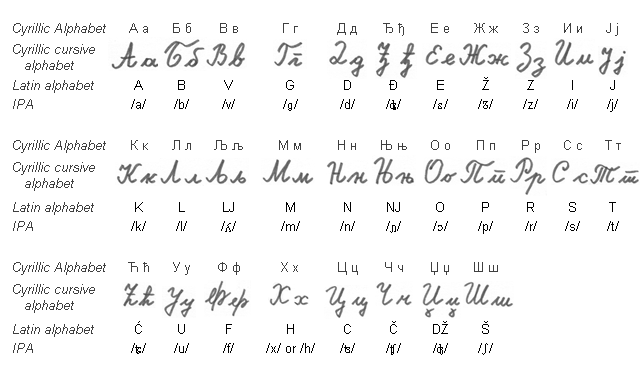 A decree was passed on January 3, 1915, that banned Serbian Cyrillic completely from public use. An imperial order in October 25, 1915, banned the use of Serbian Cyrillic in the Condominium of Bosnia and Herzegovina, except «within the scope of Serbian Orthodox Church authorities».[10][11]
A decree was passed on January 3, 1915, that banned Serbian Cyrillic completely from public use. An imperial order in October 25, 1915, banned the use of Serbian Cyrillic in the Condominium of Bosnia and Herzegovina, except «within the scope of Serbian Orthodox Church authorities».[10][11]
World War II[edit]
See also: Genocide of Serbs in the Independent State of Croatia and Axis occupation of Serbia
In 1941, the Nazi puppet Independent State of Croatia banned the use of Cyrillic,[12] having regulated it on 25 April 1941,[13] and in June 1941 began eliminating «Eastern» (Serbian) words from Croatian, and shut down Serbian schools.[14][15]
The Serbian Cyrillic alphabet was used as a basis for the Macedonian alphabet with the work of Krste Misirkov and Venko Markovski.
Yugoslavia[edit]
The Serbian Cyrillic script was one of the two official scripts used to write Serbo-Croatian in Yugoslavia since its establishment in 1918, the other being Gaj’s Latin alphabet (latinica).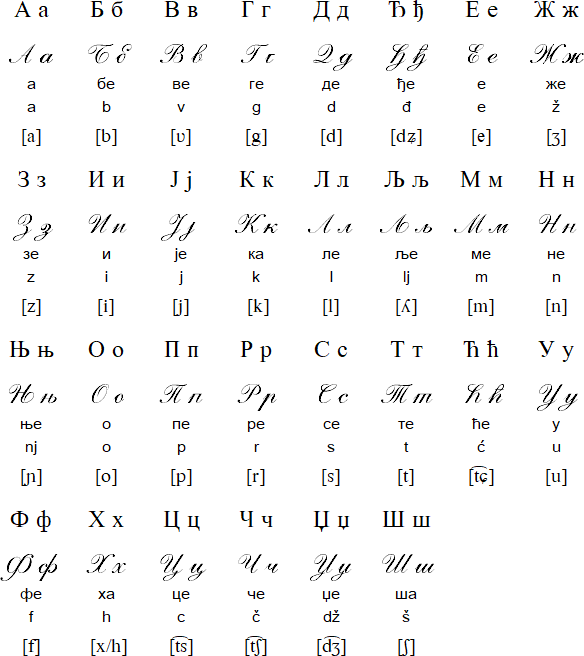
Following the breakup of Yugoslavia in the 1990s, Serbian Cyrillic is no longer used in Croatia on national level, while in Serbia, Bosnia and Herzegovina, and Montenegro it remained an official script.[16]
Contemporary period[edit]
Under the Constitution of Serbia of 2006, Cyrillic script is the only one in official use.[17]
Special letters[edit]
The ligatures:
| Ђ ђ | Љ љ | Њ њ | Ћ ћ | Џ џ |
were developed specially for the Serbian alphabet.
- Karadžić based the letters ⟨Љ⟩ and ⟨Њ⟩ on a design by Serb linguist, grammarian, philologist, and poet Sava Mrkalj, known for his attempt to reform the Serbian language before, combining the letters ⟨Л⟩ (L) and ⟨Н⟩ (N) with the soft sign (Ь).
- Karadžić based ⟨Џ⟩ on letter «Gea» in the Old Serbian Cyrillic alphabet.[citation needed]
- ⟨Ћ⟩ was adopted by Karadžić to represent the voiceless alveolo-palatal affricate (IPA: /tɕ/).
 The letter was based on, but different in appearance to, the letter Djerv, which is the 12th letter of the Glagolitic alphabet; that letter had been used in written Serbian since the 12th century, to represent /ɡʲ/, /dʲ/ and /dʑ/.
The letter was based on, but different in appearance to, the letter Djerv, which is the 12th letter of the Glagolitic alphabet; that letter had been used in written Serbian since the 12th century, to represent /ɡʲ/, /dʲ/ and /dʑ/. - Karadžić adopted a design by Serbian poet, prose writer, polyglot, and Serbian Orthodox bishop Lukijan Mušicki for the letter ⟨Ђ⟩. It was based on the letter ⟨Ћ⟩, as adapted by Karadžić.
- ⟨Ј⟩ was adopted from the Latin alphabet, apparently in preference to ⟨Й⟩.
Differences from other Cyrillic alphabets[edit]
See also: Cyrillic alphabets
Alternate variants of lowercase Cyrillic letters: Б/б, Д/д, Г/г, И/и, П/п, Т/т, Ш/ш.
Default Russian (Eastern) forms on the left.
Alternate Bulgarian (Western) upright forms in the middle.
Alternate Serbian/Macedonian (Southern) italic forms on the right.
See also:
Serbian Cyrillic does not use several letters encountered in other Slavic Cyrillic alphabets.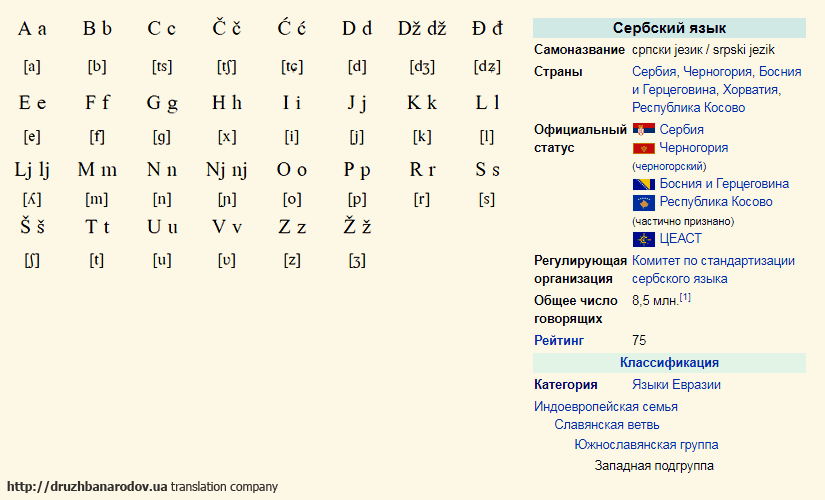 It does not use hard sign (ъ) and soft sign (ь), but the aforementioned soft-sign ligatures instead. It does not have Russian/Belarusian Э, Ukrainian/Belarusian І, the semi-vowels Й or Ў, nor the iotated letters Я (Russian/Bulgarian ya), Є (Ukrainian ye), Ї (yi), Ё (Russian yo) or Ю (yu), which are instead written as two separate letters: Ја, Је, Ји, Јо, Ју. Ј can also be used as a semi-vowel, in place of й. The letter Щ is not used. When necessary, it is transliterated as either ШЧ, ШЋ or ШТ.
It does not use hard sign (ъ) and soft sign (ь), but the aforementioned soft-sign ligatures instead. It does not have Russian/Belarusian Э, Ukrainian/Belarusian І, the semi-vowels Й or Ў, nor the iotated letters Я (Russian/Bulgarian ya), Є (Ukrainian ye), Ї (yi), Ё (Russian yo) or Ю (yu), which are instead written as two separate letters: Ја, Је, Ји, Јо, Ју. Ј can also be used as a semi-vowel, in place of й. The letter Щ is not used. When necessary, it is transliterated as either ШЧ, ШЋ or ШТ.
Serbian italic and cursive forms of lowercase letters б, г, д, п, and т (Russian Cyrillic alphabet) differ from those used in other Cyrillic alphabets: б, г, д, п, and т (Serbian Cyrillic alphabet). The regular (upright) shapes are generally standardized among languages and there are no officially recognized variations.[18][19] That presents a challenge in Unicode modeling, as the glyphs differ only in italic versions, and historically non-italic letters have been used in the same code positions. Serbian professional typography uses fonts specially crafted for the language to overcome the problem, but texts printed from common computers contain East Slavic rather than Serbian italic glyphs. Cyrillic fonts from Adobe,[20] Microsoft (Windows Vista and later) and a few other font houses[citation needed] include the Serbian variations (both regular and italic).
Serbian professional typography uses fonts specially crafted for the language to overcome the problem, but texts printed from common computers contain East Slavic rather than Serbian italic glyphs. Cyrillic fonts from Adobe,[20] Microsoft (Windows Vista and later) and a few other font houses[citation needed] include the Serbian variations (both regular and italic).
If the underlying font and Web technology provides support, the proper glyphs can be obtained by marking the text with appropriate language codes. Thus, in non-italic mode:
<span lang="sr">бгдпт</span>, produces in Serbian language script: бгдпт, same (except for the shape of б) as<span lang="ru">бгдпт</span>, producing in Russian language script: бгдпт
whereas:
<span lang="sr">бгдпт</span>gives in Serbian language script: бгдпт, and<span lang="ru">бгдпт</span>produces in Russian language script: бгдпт. «Unicode 8.0.0 ch.02 p.14-15» (PDF).
«Unicode 8.0.0 ch.02 p.14-15» (PDF).- Ćirković, Sima (2004). The Serbs. Malden: Blackwell Publishing. ISBN 9781405142915.
- Isailović, Neven G.; Krstić, Aleksandar R. (2015). «Serbian Language and Cyrillic Script as a Means of Diplomatic Literacy in South Eastern Europe in 15th and 16th Centuries». Literacy Experiences concerning Medieval and Early Modern Transylvania. Cluj-Napoca: George Bariţiu Institute of History. pp. 185–195.
- Ivić, Pavle, ed. (1995). The History of Serbian Culture. Edgware: Porthill Publishers. ISBN 9781870732314.
- Samardžić, Radovan; Duškov, Milan, eds. (1993). Serbs in European Civilization. Belgrade: Nova, Serbian Academy of Sciences and Arts, Institute for Balkan Studies. ISBN 9788675830153.
- Sir Duncan Wilson, The life and times of Vuk Stefanović Karadžić, 1787-1864: literacy, literature and national independence in Serbia, p.
 387. Clarendon Press, 1970. Google Books
387. Clarendon Press, 1970. Google Books - Omniglot – Serbian and Croatian
Sources[edit]
External links[edit]
кодировок шрифтов — сербская латиница и кириллица — TeX
спросил
Изменено
3 года, 1 месяц назад
Просмотрено
3к раз
Я использую пакет fontenc для написания текстов сербской латиницей (кодировка OT1) или сербской кириллицей (кодировка OT2). Моя цель состоит в том, чтобы набрать значительное количество основного текста, скомпилировав один код LaTeX, и создать выходной текст на сербской латинице или на сербской кириллице в зависимости от используемой кодировки fontenc. Однако это представляется невозможным, так как переключение с одной кодировки fontenc на другую подразумевает использование разных представлений букв в коде LaTeX. Например, буква ž (латиница) идентична букве ж (кириллица). Тем не менее, они должны быть по-разному закодированы в OT1 и OT2 как \v{z} и zh соответственно. Ниже я привел два примера, в которых одно и то же предложение, означающее «Возможно, Новак Джокович может выиграть матч против Надаля на грунте», имеет два выхода (латиницу и кириллицу), но их коды LaTeX, к сожалению, разные и не универсальные, как хотелось бы. Любая помощь будет более чем приветствуется. Заранее спасибо.
Например, буква ž (латиница) идентична букве ж (кириллица). Тем не менее, они должны быть по-разному закодированы в OT1 и OT2 как \v{z} и zh соответственно. Ниже я привел два примера, в которых одно и то же предложение, означающее «Возможно, Новак Джокович может выиграть матч против Надаля на грунте», имеет два выхода (латиницу и кириллицу), но их коды LaTeX, к сожалению, разные и не универсальные, как хотелось бы. Любая помощь будет более чем приветствуется. Заранее спасибо.
% Пример_1
\documentclass{scrartcl}
\usepackage[OT1]{шрифт}
\usepackage[английский,сербский]{babel}
\начать{документ}
Mo\v{z}da Novak \DJ{}okovi\'{c} mo\v{z}e da osvoji me\v{c} против Nadala na \v{s}ljaci.
\конец{документ}
% Пример_2
\documentclass{scrartcl}
\usepackage[OT2]{шрифт}
\usepackage[английский,сербский]{babel}
\начать{документ}
Можда Новак Джокович1 може да овладей мечом против Надала на шлячи.
\конец{документ}
- кодировки шрифтов
- кириллица
2
Для сербского языка лучше всего использовать пакет cmsrb. Вы также получите правильный курсив кириллических курсивных букв.
Вы также получите правильный курсив кириллических курсивных букв.
\documentclass{статья}
\usepackage{cmsrb}
\usepackage[OT2,T1]{fontenc} %лучше использовать T1, но OT1 тоже будет работать
\usepackage[сербский]{бабель}
\начать{документ}
Mo\v{z}da Novak \DJ{}okovi\'{c} mo\v{z}e da osvoji me\v{c} против Nadala na \v{s}ljaci.
\textit{abc\v c\'cdd\v z\dj efghijklljmnnjoprs\v stuvz\v z}
\fontencoding{OT2}\selectfont
Mo\v{z}da Novak \DJ{}okovi\'{c} mo\v{z}e da osvoji me\v{c} против Nadala na \v{s}ljaci.
\textit{abc\v c\'cdd\v z\dj efghijklljmnnjoprs\v stuvz\v z}
\конец{документ}
Это также будет работать с вводом UTF-8.
2
Я предлагаю использовать ввод UTF-8. Единственная проблема с «Дж» и «Дж», которые нужно вводить \ДЗ и \дз соответственно.
\documentclass{статья}
\usepackage[OT2,OT1]{шрифт}
\usepackage[английский,сербский]{babel}
\DeclareTextCompositeCommand{\v}{OT2}{C}{Ch}
\DeclareTextCompositeCommand{\v}{OT2}{c}{ch}
\DeclareTextCompositeCommand{\v}{OT2}{S}{Sh}
\DeclareTextCompositeCommand{\v}{OT2}{s}{sh}
\DeclareTextCompositeCommand{\v}{OT2}{Z}{Zh}
\DeclareTextCompositeCommand{\v}{OT2}{z}{zh}
\DeclareTextCompositeCommand{\'}{OT2}{C}{C1}
\DeclareTextCompositeCommand{\'}{OT2}{c}{c1}
\DeclareTextCommand{\DJ}{OT2}{Dj}
\DeclareTextCommand{\dj}{OT2}{dj}
\DeclareTextCommand{\DZ}{OT1}{Dž}
\DeclareTextCommand{\DZ}{OT2}{D2}
\DeclareTextCommand{\dz}{OT1}{dž}
\DeclareTextCommand{\dz}{OT2}{d2}
\makeatletter
\g@addto@macro\@uclclist{\dj\DJ\dz\DZ}
\ сделать другое
\начать{документ}
Можда Новак Джокович может быть против Надала на шляци. {\footnotesize\MakeUppercase{Можда Новак Джокович может быть против Надала на шляци.}\par}
A B C Č Ć D \DZ\ Ð E F G H I J K L Lj M N Nj O P R S Š T U V Z Ž
a b c č ć d \dz\ đ e f g h i j k l lj m n nj o p r s š t u v z ž
\MakeUppercase{a b c č ć d \dz\ đ e f g h i j k l lj m n nj o p r s š t u v z ž}
\bigskip
\fontencoding{OT2}\selectfont
Можда Новак Джокович может быть против Надала на шляци.
{\footnotesize\MakeUppercase{Можда Новак Джокович может быть против Надала на шляци.}\par}
A B V G D Đ E Ž Z I J K L Lj M N Nj O P R S T Ć U F H C Č \DZ\ Š
а б v г d đ е ž z i j k l lj m n nj o p r s t ć u f h c č \dz\ š
\MakeUppercase{a b v g d đ e ž z i j k l lj m n nj o p r s t ć u f h c č \dz\ š}
\конец{документ}
{\footnotesize\MakeUppercase{Можда Новак Джокович может быть против Надала на шляци.}\par}
A B C Č Ć D \DZ\ Ð E F G H I J K L Lj M N Nj O P R S Š T U V Z Ž
a b c č ć d \dz\ đ e f g h i j k l lj m n nj o p r s š t u v z ž
\MakeUppercase{a b c č ć d \dz\ đ e f g h i j k l lj m n nj o p r s š t u v z ž}
\bigskip
\fontencoding{OT2}\selectfont
Можда Новак Джокович может быть против Надала на шляци.
{\footnotesize\MakeUppercase{Можда Новак Джокович может быть против Надала на шляци.}\par}
A B V G D Đ E Ž Z I J K L Lj M N Nj O P R S T Ć U F H C Č \DZ\ Š
а б v г d đ е ž z i j k l lj m n nj o p r s t ć u f h c č \dz\ š
\MakeUppercase{a b v g d đ e ž z i j k l lj m n nj o p r s t ć u f h c č \dz\ š}
\конец{документ}
Правильным решением было бы использовать XeLaTeX, см. https://tex.stackexchange.com/a/44740/4427
1
Зарегистрируйтесь или войдите в систему
Зарегистрируйтесь с помощью Google
Зарегистрироваться через Facebook
Зарегистрируйтесь, используя адрес электронной почты и пароль
Опубликовать как гость
Электронная почта
Требуется, но никогда не отображается
Опубликовать как гость
Электронная почта
Требуется, но не отображается
Нажимая «Опубликовать свой ответ», вы соглашаетесь с нашими условиями обслуживания, политикой конфиденциальности и политикой использования файлов cookie
Выучить сербскую кириллицу: пошаговое руководство
Автор: Olivera Tolimir
Если вы задали себе (и Google) вопрос из заголовка, вы, вероятно, попадаете в одну из двух групп людей, которые хотят выучить сербский .
Первая группа : вы уже начали учить сербский и поняли, что это не так плохо, как вы думали. Есть некоторые сложные моменты, но их можно освоить, так что вы чувствуете себя хорошо. Замечательно!
Но (всегда есть «но») вам все равно неловко из-за того, что вы избегаете одной части сербского языка — кириллицы. Вы думаете, что пришло время взглянуть правде в глаза, и вы готовы освоить этот странный алфавит! Поздравляем, и давайте погрузимся прямо в это!
Если вы не нашли себя в приведенном выше описании, значит, вы принадлежите к второй группе , поэтому ваш текущий мыслительный процесс, вероятно, выглядит так: «Подождите, я еще не начал учить сербский, так что Я ничего не понимаю. Как ты можешь что-то знать о языке, если ты еще не знаешь букв?! Если это относится к вам, может быть, нам стоит сделать шаг назад и сказать что-нибудь о сербском алфавите s (множественное число не является ошибкой).
На гербе Сербии буквы S-S-S-S, а не C-C-C-C! Вы знаете, что они представляют?
Два алфавита сербского языка
Одной из отличительных особенностей сербского языка являются два алфавита – кириллица и латиница.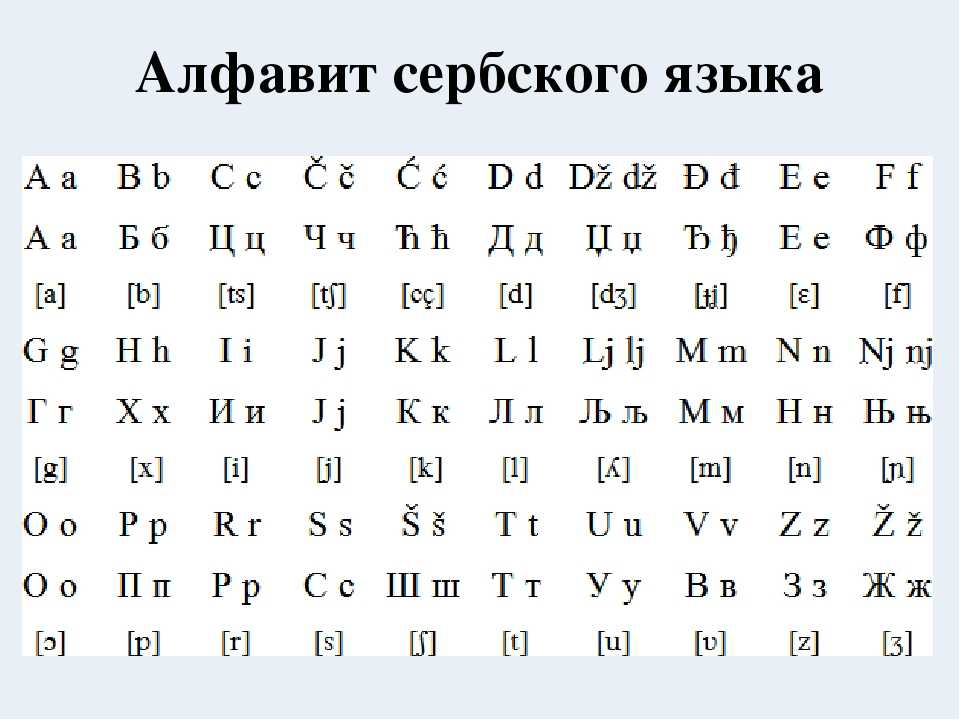 В нашем языке 30 звуков, обозначаемых буквой в обоих алфавитах. Итак, в обоих алфавитах 30 букв соответствуют 30 звукам. Кириллица называется азбука , а латиница – это абеседа . Это означает, что вы можете написать каждое слово на сербском двумя разными способами.
В нашем языке 30 звуков, обозначаемых буквой в обоих алфавитах. Итак, в обоих алфавитах 30 букв соответствуют 30 звукам. Кириллица называется азбука , а латиница – это абеседа . Это означает, что вы можете написать каждое слово на сербском двумя разными способами.
Если это звучит сложно, не волнуйтесь. Это не. Наш язык фонетический — мы произносим слова так же, как пишем их. Это означает, что как только вы выучите сербские буквы, вы сможете читать и писать все, что захотите! Мы уже упоминали об этом забавном факте в одном из наших предыдущих текстов, где вы также можете найти самое длинное слово на сербском языке!
Теперь, когда мы вспомнили важную информацию о сербских алфавитах, мы можем шаг за шагом выучить сербскую кириллицу! Да, и еще одно: если вы абсолютный новичок в сербском и ваш родной язык использует латиницу, было бы разумно выучить латинскую версию сербских букв, прежде чем погрузиться в кириллицу. Это значительно облегчит вам процесс обучения.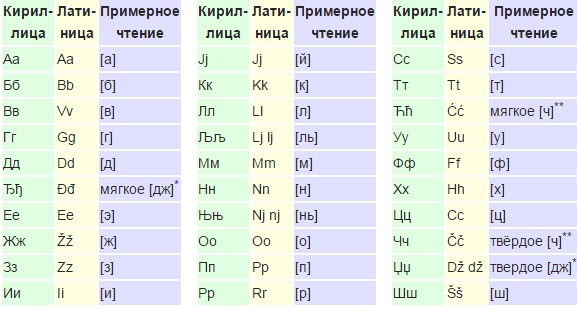 С другой стороны, если ваш родной язык использует кириллицу и вы достаточно хорошо знаете английский, чтобы читать этот текст, вам повезло! Оба наших алфавита понравятся вам!
С другой стороны, если ваш родной язык использует кириллицу и вы достаточно хорошо знаете английский, чтобы читать этот текст, вам повезло! Оба наших алфавита понравятся вам!
Буквенное братство
Лучший способ выучить сербскую кириллицу — разделить 30 букв на группы и запомнить их, группа за группой. Есть сербская пословица: Sličan se sličnom raduje . Это означает, что люди, которые похожи, имеют тенденцию ладить. Давайте подумаем о наших письмах таким же образом. Разделим их на группы:
- Буквы, которые пишутся так же, как в латинице
- Буквы, отличные от латиницы
- Буквы, которые пишутся так же, как некоторые латинские, но произносятся по-другому.
Буквы пишутся так же, как в латинице
Некоторые буквы пишутся одинаково в кириллице и латинице. Это будет самым простым для вас, чтобы запомнить:
A — произносится как A в Serbian Word A VION (Airplane)
E — произносится как E в 7777777777 — произносится как E в 7 777777777 — произносится как E в 7 7 7 — произносится как e в — Эон . 0105 Vropa (Европа)
0105 Vropa (Европа)
J — произносится как J в J UTRO (утро)
K — произносится как K в K 7777777777777777777777777777777777777777 9.
O — произносится как O в O GLEDALO (MIRROR)
9007 GLEDALO (MIRROR)
9000 9007 9007 9007 9007 . т рава (трава).
Выучите сербскую кириллицу легко!
Буквы, отличные от латинских
Б – в латинице: B (латиница: b anana; кириллица: Б АНАНА)
Г – в латинице: g uska; кириллица: Г УСКА) – «guska» означает «гусь»
Д – латиницей: D (латиница: d rvo; кириллица: Д РВО) – «дрво» означает дерево – латиницей: Đ (латиница: đ ak; кириллица: Ђ АК) – «đak» означает «студент»
Ж – латиницей: Ž (латиница: ž aba; кириллица: Ж АБА) – «жаба» означает «лягушка» и сверху выглядит как лягушка
З – латиницей: Z (лат.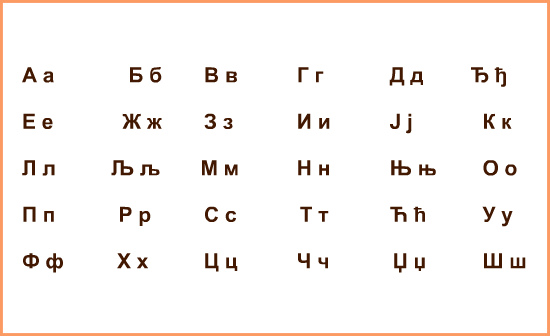 0076 z эбра; Кириллица: З ЕБРА). Поскольку это похоже на цифру 3, попробуйте вспомнить предложение «В зоопарке 3 зебры»!
0076 z эбра; Кириллица: З ЕБРА). Поскольку это похоже на цифру 3, попробуйте вспомнить предложение «В зоопарке 3 зебры»!
И – в латинице: I (латиница: и гла; кириллица: И ГЛА) – «игла» означает «игла». Это похоже на 3 иглы, соединенные вместе.
Л — латиницей: L (латиница: l eopard; кириллица: Л ЕОПАРД)
Љ — латиницей: LJ (латиница: lj ubav; Кириллица: Љ УБАВ) – «любав» означает «любовь». Постарайтесь запомнить, что Љ выглядит как беременная Л, поэтому она будет напоминать вам о любви. 🙂
њ — в латинском алфавите: NJ (латынь: njuШКА; Cyrillic: њ UшKA) — «NJUOTHKA» означает «Сьюнту»
. — в лат -алфите: P (Pnout »
p — в лат -алфите: p rase; кириллица: П РАСЕ) – «prase» означает «свинья»
Ф – латиницей: F (латиница: F rancuska, кириллица: Ф РАНЦУСКА) – Francuska означает «Франция»
Ц – латиницей: C означает «церковь». Он выглядит как перевернутый ch воздух, поэтому он может помочь вам запомнить произношение.
Он выглядит как перевернутый ch воздух, поэтому он может помочь вам запомнить произношение.
Џ – латиницей: DŽ (латиница: дж в; Кириллица: Џ ИН) – «джак» означает «великан», а слова «джак» и «великан» начинаются с одного и того же звука.
Ш – в латинице: Š (латиница: š uma; кириллица: Ш УМА) – «шума» означает «лес» B – в латинице: V (латиница: v everica; кириллица: В ЕВЕРИЦА) – «veverica» означает «белка». Вы знаете, как выглядит белка с полным ртом фундука? Его щеки выглядят круглыми, как буква Б.
Н – в латинице: N (латиница: n e; кириллица: Н Е) – «ne» означает «нет» ужа; кириллица: Р УЖА) – «ружа» означает «роза» мечтать». Постарайтесь запомнить его связь с латинским аналогом, вспомнив, что он выглядит как половина буквы S.

 The letter was based on, but different in appearance to, the letter Djerv, which is the 12th letter of the Glagolitic alphabet; that letter had been used in written Serbian since the 12th century, to represent /ɡʲ/, /dʲ/ and /dʑ/.
The letter was based on, but different in appearance to, the letter Djerv, which is the 12th letter of the Glagolitic alphabet; that letter had been used in written Serbian since the 12th century, to represent /ɡʲ/, /dʲ/ and /dʑ/. «Unicode 8.0.0 ch.02 p.14-15» (PDF).
«Unicode 8.0.0 ch.02 p.14-15» (PDF).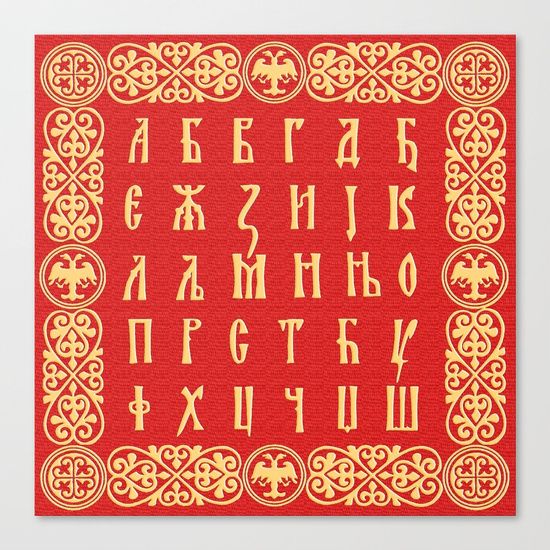 387. Clarendon Press, 1970. Google Books
387. Clarendon Press, 1970. Google Books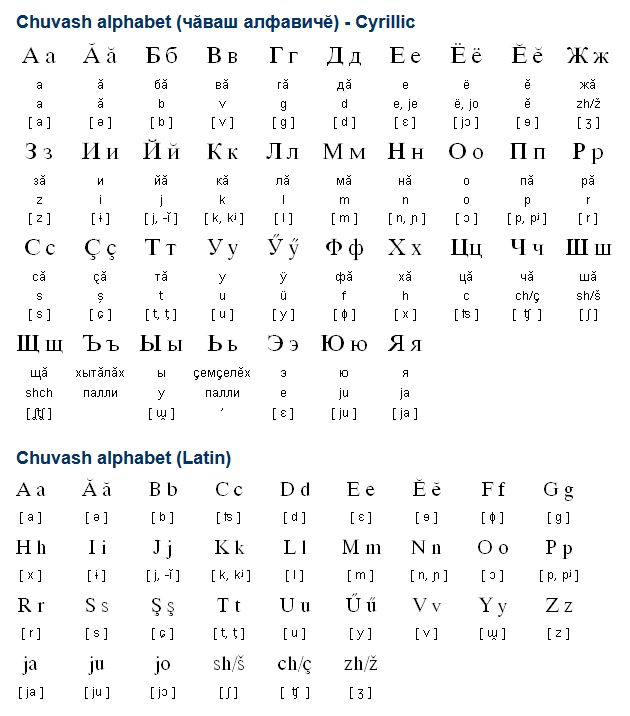 {\footnotesize\MakeUppercase{Можда Новак Джокович может быть против Надала на шляци.}\par}
A B C Č Ć D \DZ\ Ð E F G H I J K L Lj M N Nj O P R S Š T U V Z Ž
a b c č ć d \dz\ đ e f g h i j k l lj m n nj o p r s š t u v z ž
\MakeUppercase{a b c č ć d \dz\ đ e f g h i j k l lj m n nj o p r s š t u v z ž}
\bigskip
\fontencoding{OT2}\selectfont
Можда Новак Джокович может быть против Надала на шляци.
{\footnotesize\MakeUppercase{Можда Новак Джокович может быть против Надала на шляци.}\par}
A B V G D Đ E Ž Z I J K L Lj M N Nj O P R S T Ć U F H C Č \DZ\ Š
а б v г d đ е ž z i j k l lj m n nj o p r s t ć u f h c č \dz\ š
\MakeUppercase{a b v g d đ e ž z i j k l lj m n nj o p r s t ć u f h c č \dz\ š}
\конец{документ}
{\footnotesize\MakeUppercase{Можда Новак Джокович может быть против Надала на шляци.}\par}
A B C Č Ć D \DZ\ Ð E F G H I J K L Lj M N Nj O P R S Š T U V Z Ž
a b c č ć d \dz\ đ e f g h i j k l lj m n nj o p r s š t u v z ž
\MakeUppercase{a b c č ć d \dz\ đ e f g h i j k l lj m n nj o p r s š t u v z ž}
\bigskip
\fontencoding{OT2}\selectfont
Можда Новак Джокович может быть против Надала на шляци.
{\footnotesize\MakeUppercase{Можда Новак Джокович может быть против Надала на шляци.}\par}
A B V G D Đ E Ž Z I J K L Lj M N Nj O P R S T Ć U F H C Č \DZ\ Š
а б v г d đ е ž z i j k l lj m n nj o p r s t ć u f h c č \dz\ š
\MakeUppercase{a b v g d đ e ž z i j k l lj m n nj o p r s t ć u f h c č \dz\ š}
\конец{документ}